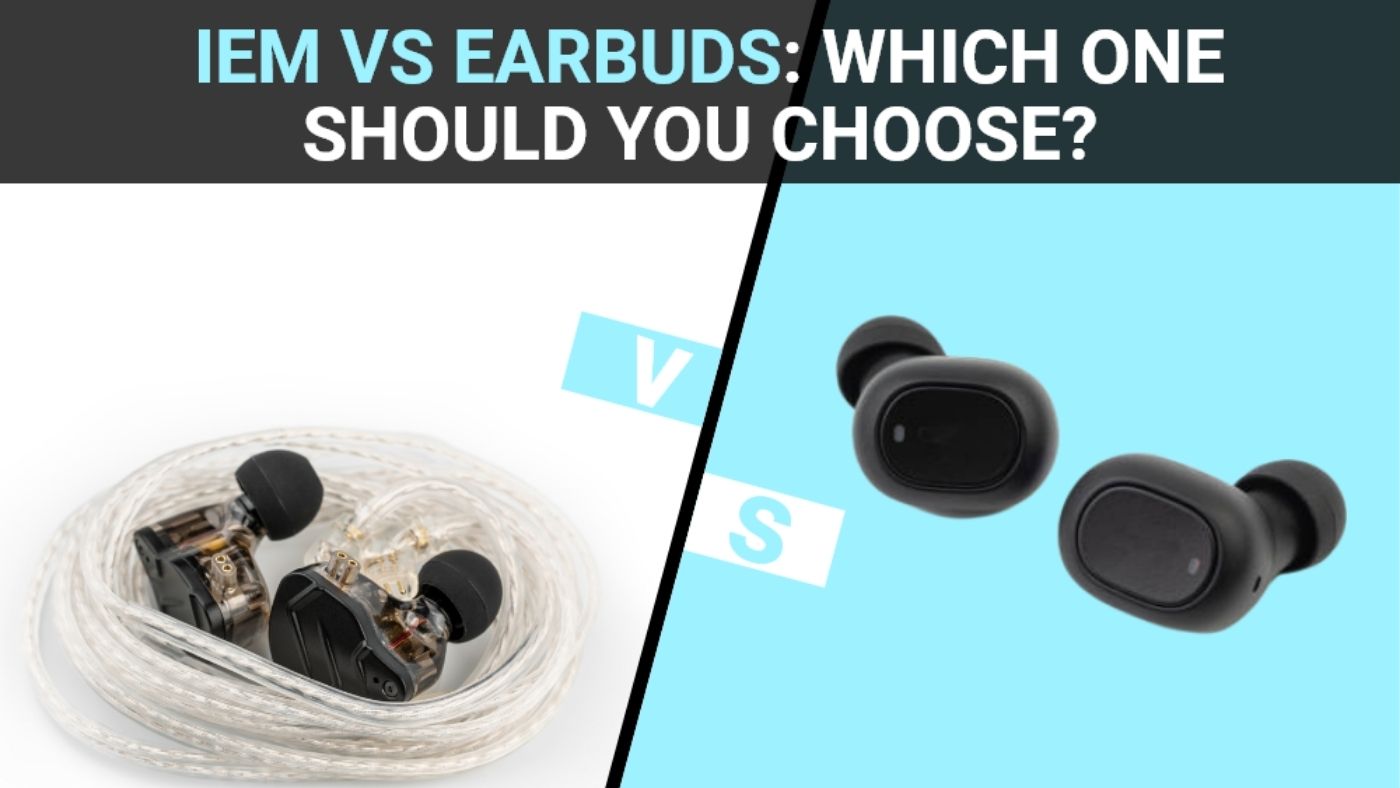El debate entre over-ear, in-ear monitores (IEM) y auriculares ha estado en curso durante bastante tiempo. Muchos entusiastas de la música juran por su elección de equipo de audio preferido, promocionando las ventajas de cada tecnología sobre su competidor. Con una variedad de características para elegir y opiniones conflictivas que compiten por la atención en la web, puede ser difícil evaluar qué tecnología es la mejor para usted y sus necesidades particulares. Hemos realizado la investigación y hemos reunido nuestros hallazgos sobre los IEM frente a los auriculares para que pueda tomar una decisión más informada al seleccionar su próximo conjunto de productos de audio personales.
Hay mucho que considerar al elegir auriculares y dispositivos de escucha. ¿Vas por (IEM) o te conformas con los auriculares? Invertir en IEM puede brindarle la mejor experiencia de sonido, permitiéndole disfrutar de la música exactamente como el artista pretendía. Mientras que los (IEM) generalmente cuestan más que los auriculares, durarán mucho más tiempo y pueden proporcionar una calidad de sonido superior. Elegir la opción correcta también depende del estilo de vida. (IEM) son ideales para aquellos con un estilo de vida activo, mientras que los auriculares podrían ser más adecuados si su principal prioridad es la asequibilidad y la portabilidad. Teniendo en cuenta todas estas consideraciones garantiza que se pueda seleccionar el dispositivo de audio perfecto.
IEMs vs. Auriculares

El debate entre (IEMs) (In-Ear-Monitores) y auriculares ha estado sucediendo durante algún tiempo. En última instancia, es una preferencia personal, pero los IEM generalmente ofrecen una calidad de sonido superior debido a su diseño personalizado.
Pueden proporcionar un mejor aislamiento del mundo exterior, creando una inmersión en el paisaje sonoro que los auriculares tradicionales no ofrecen. Por otro lado, los auriculares son más versátiles y portátiles al proporcionar un diseño más ligero y no tienen fugas, lo que los hace perfectos para escuchar en entornos públicos o mientras viaja.
Aunque la calidad del sonido puede estar ligeramente comprometida, esto los hace ideales para la escucha casual, todos los cuales son factores considerados al elegir entre (IEM) frente a auriculares.
UNA. Explicación de los IEMs
Los monitores intrauditivos (IEM) son dispositivos de audio que permiten a los usuarios tener una experiencia de escucha personal con varias fuentes de audio. Los músicos profesionales suelen usar IEM durante las actuaciones, ya que pueden proporcionar una claridad y precisión de sonido mejoradas y una comodidad mejorada en comparación con los auriculares o auriculares tradicionales. Trabajan proporcionando un ajuste personalizado con sus puntas de silicona o espuma que crean un sello acústico en el canal auditivo. Esto ayuda a minimizar la interferencia externa del sonido y crea un entorno óptimo para una mejor reproducción del sonido.
1. Beneficios de los IEMs
Los monitores intrauditivos (IEM) son una herramienta preciosa en la vida de cualquier músico, que ofrece varias ventajas sobre los auriculares tradicionales. Los IEM se asientan directamente dentro del canal auditivo del usuario y ofrecen una calidad de sonido superior a volúmenes más bajos: esto es más cómodo para el oyente y ayuda a proteger la audición.
Además, los IEM proporcionan un mayor control sobre la cancelación de ruido y crean un escenario sonoro, que es esencial al grabar o realizar música en vivo. Además, vienen en varios estilos y precios para que pueda encontrar el ajuste perfecto para sus necesidades diarias. Invirtiendo en buena calidad, los IEM ofrecen beneficios significativos a los músicos en cualquier etapa de su carrera.
2. Inconvenientes de los IEMs
Los IEM (monitores In-Ear), con su aislamiento de ruido superior y su respuesta de graves profundos, son populares entre los artistas intérpretes o ejecutantes y los audiófilos. Sin embargo, el aumento de la presión en el oído causado por el sellado hermético de los IEM puede conducir a la distorsión del sonido a volúmenes más altos y la incomodidad de las sesiones de escucha prolongadas.
Además, como cualquier residuo entra en el auricular, sus oídos deben estar atentos para limpiarlo, o podría causar daño físico potencial al canal auditivo. Además, dependiendo de su tamaño y forma, la colocación de un IEM correctamente en el oído puede tomar algún tiempo para acostumbrarse. Todos estos factores han desalentado a algunos de usar IEM por completo.
B. Explicación de los earbuds
Los auriculares son fuentes de audio pequeñas y portátiles diseñadas para encajar dentro del canal auditivo. Proporcionan una alternativa conveniente a los auriculares sobre la oreja y a los dispositivos de proyección de audio grandes y voluminosos. Los auriculares consisten en uno o más altavoces (o controladores) encerrados en una carcasa aislada que se usa en los oídos de un usuario. Los diferentes diseños incluyen características como cancelación de ruido o amplificación de sonido que se pueden ajustar para satisfacer las necesidades de los usuarios.
Los modelos más avanzados incluyen características adicionales como la conectividad Bluetooth y la resistencia al agua/sudor para una mayor durabilidad. Su diseño compacto hace que los auriculares sean fáciles de transportar, lo que los hace extremadamente populares entre los usuarios modernos que buscan una calidad de sonido más precisa con poca molestia o peso.
1. Beneficios de los earbuds
Los auriculares ofrecen una ventaja notable en comparación con los auriculares tradicionales, ya que son livianos y compactos, lo que los hace increíblemente portátiles e ideales para escuchar el audio sobre la marcha. Además, los auriculares se encuentran en el punto óptimo entre ofrecer un sonido de calidad y seguir bloqueando el ruido de fondo. Esto los hace perfectos para disfrutar de la música o los audiolibros sin distraerse con la vida diaria. Además, como los auriculares generalmente vienen con múltiples tamaños de puntas y alas de silicona, es más fácil para usted encontrar el ajuste perfecto para un ajuste cómodo y seguro. Los beneficios de los auriculares los convierten en una opción sensata para cualquiera que busque un sonido y comodidad óptimos.
2. Inconvenientes de los earbuds
Los auriculares están creciendo en popularidad como una forma conveniente de escuchar audio, pero tienen algunos inconvenientes. Uno de los problemas importantes es la fuga de sonido: debido a que los auriculares se encuentran directamente dentro de su canal auditivo, pueden filtrar el sonido que pueden escuchar quienes se sientan cerca. Esta falta de aislamiento acústico también significa que los ruidos ambientales pueden distraer más y evitar que escuche contenido de audio. Además, aunque muchos usuarios cambian las puntas de sus oídos y encuentran alternativas de tamaño, un ajuste deficiente puede provocar molestias durante largos períodos de escucha o sonidos amortiguados debido a un sellado inadecuado. Finalmente, debido a la naturaleza cómoda de cómo los auriculares encajan dentro de la carcasa de sus oídos, los gérmenes y las bacterias pueden acumularse en ellos más rápidamente que los auriculares más gigantes.
C. Comparación de IEMs y auriculares
Los monitores intrauditivos (IEM) y los auriculares son dos auriculares populares disponibles en el mercado, pero difieren en diseño y calidad de sonido. Los IEM implican insertar un par de auriculares con aislamiento de ruido en el oído mientras los auriculares descansan justo fuera de él. En cuanto al sonido, los IEM proporcionan una mayor precisión y claridad acústica en comparación con los auriculares porque utilizan puntas de silicona o espuma que bloquean el ruido ambiental no deseado. Mientras tanto, los auriculares tienen un diseño abierto, lo que los hace más cómodos y transpirables, pero permiten que los sonidos externos interrumpan la experiencia auditiva. En última instancia, se trata de elegir el auricular adecuado según sus necesidades, con IEM que proporcionan una calidad de audio superior en entornos ruidosos como conciertos o eventos en vivo. Al mismo tiempo, los auriculares se utilizan mejor en entornos más silenciosos.
1. Calidad de sonido
Los IEM proporcionan una calidad de sonido mucho más alta debido a su ajuste directo que bloquea el ruido externo, mientras que los auriculares permiten que se filtre algo de ruido externo. Esto hace que los IEM sean superiores para aplicaciones de escucha crítica y de estudio, ya que proporcionan mejores detalles y claridad que cualquier otro tipo de auriculares.
2. Comodidad
Los IEM cuentan con controladores montados en una pequeña carcasa que encaja directamente en el oído, mientras que los auriculares son generalmente unidades más pequeñas colocadas justo fuera del canal auditivo.
3. Aislamiento de ruido
Una de las diferencias más críticas entre los monitores intrauditivos (IEM) y los auriculares es el aislamiento del ruido. Los IEM vienen con puntas de espuma o silicona que se asientan cómodamente en el canal auditivo, creando un sello casi perfecto. Esto proporciona una calidad de sonido mucho mejor en general, junto con un énfasis adicional en los tonos de graves y la reducción del ruido exterior al bloquear todo menos la música en sí.
4. Portabilidad
Especialmente con respecto a la portabilidad, los IEM tienden a ofrecer un equilibrio bastante decente entre calidad de sonido, tamaño y conveniencia. Muchos modelos ofrecen un diseño ergonómico que se sienta cómodamente en los oídos, así como tecnología de cancelación de ruido para un ambiente al aire libre más silencioso. Por otro lado, los auriculares son generalmente más ligeros y elegantes que los IEM, pero sacrifican un poco la calidad del sonido al hacerlo.
Factores a considerar al elegir entre IEMs y auriculares

Aquí hay algunos factores a considerar al elegir entre IEM y Auriculares.
UNA. Personal Preferencia
Cuando se trata de elegir entre IEM (In-Ear Monitores) y auriculares, hay algunos factores a tener en cuenta. En primer lugar, uno debe pensar en las preferencias personales. ¿Prefiere la calidad de sonido de los IEM o la comodidad de los auriculares? Si bien los IEM a menudo se consideran dispositivos de audio superiores, aquellos que buscan portabilidad pueden elegir auriculares debido a su menor tamaño y ligereza.
B. Calidad de sonido
Cuando se trata de seleccionar un dispositivo de audio, decidir entre monitores internos (IEM) y auriculares puede ser una decisión difícil. La calidad del sonido es un factor importante; los IEM a menudo proporcionan una experiencia auditiva más detallada debido a su capacidad para adaptarse mejor al canal auditivo. Los auriculares, por otro lado, ofrecen un mejor escenario de sonido y pueden resaltar algunos detalles que los IEM pueden perder, dependiendo de su entorno y preferencias.
C. Comodidad
La comodidad siempre se debe considerar al elegir IEM o auriculares, ya que usar algo durante largos períodos puede volverse incómodo rápidamente si no se selecciona cuidadosamente.
D. Aislamiento de ruido
Otro factor a considerar es el aislamiento del ruido; ya sea que desee escuchar su audio en entornos ruidosos o dejar que su música lo envuelva en privacidad, es una elección importante que solo se puede hacer teniendo en cuenta sus propias necesidades.
Lo es. Portabilidad
La portabilidad es algo por lo que muchas personas optan a la hora de tomar su decisión. Los auriculares son generalmente limitados en términos de rendimiento de sonido y aislamiento de sonido, pero tienen un tamaño más pequeño y pesan menos que los IEM, lo que los hace más fáciles de transportar y almacenar.
Por lo tanto, al elegir un dispositivo de audio entre IEM o auriculares, debe tener en cuenta sus preferencias personales: calidad de sonido o portabilidad.
Conclusión
En esta publicación de blog, hemos discutido los pros y los contras de los IEM y los Auriculares y destacamos cuatro factores clave a considerar al elegir entre ellos. Al igual que con cualquier decisión de compra, la preferencia personal determina su mejor opción.
Sin embargo, si está buscando la mejor calidad de sonido, comodidad, aislamiento de ruido y portabilidad, entonces los IEM generalmente salen adelante.
Por lo tanto, recomiendo encarecidamente echar un vistazo más de cerca a los IEM si está listo para actualizar su experiencia de audio. Con todas estas consideraciones en mente, con suerte, puede tomar una decisión informada que se adapte a sus necesidades, ¡buena suerte!




1 comentario
Bill
pretty informative, nice article,
pretty informative, nice article,